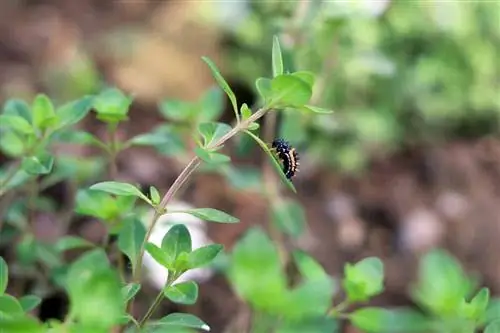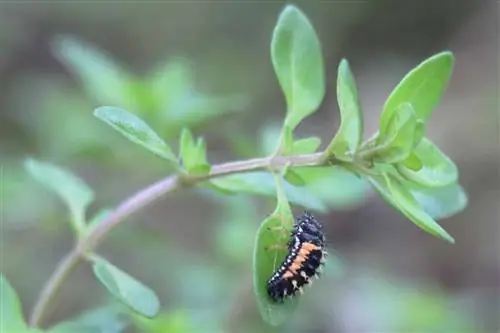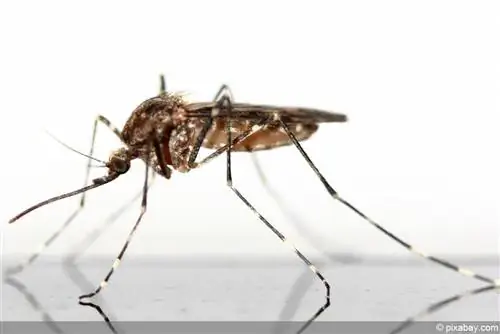- Author admin [email protected].
- Public 2023-12-17 03:39.
- Last modified 2025-01-24 12:45.
Ladybird larvae are among the best known and most popular beneficial insects in the home garden. It helps to keep a wide variety of pests at bay or to prevent them from spreading in the first place. If you don't want to leave the appearance of beneficial insects to chance, you can specifically promote them and promote them at your own location. We use helpful tips to explain how to use them safely in your own garden.
Ladybird larvae in your own garden
Proverbially, the ladybug brings good luck to those who find it or have it in their own garden. In practical terms, you can actually call it a stroke of luck that these animals make a significant contribution to keeping pests under control. Because both the ladybird and its larvae prefer to feed on the number one garden pest - the aphid:
- Ex. Seven-spot ladybird: around 100 to 150 lice per day
- Ladybird larvae from hatching to pupation approx. 400 to 600 lice
It is clear that even a few animals can make an enormous contribution to containing an infestation. But don't leave their appearance in the garden to chance. Promote the beneficial insects specifically and use them optimally to your advantage:
The winter quarters
In spring, when the temperature slowly rises again after the cold winter nights, there can be an explosive increase in pests. To ensure that the right beneficial insect is present when the aphid appears, it is worth offering the ladybug suitable overwintering opportunities in the garden. If he finds a sufficiently high temperature for protected winter torpor without the risk of frostbite, he wakes up in the spring at the same time as the lice appear and gets to work with ravenous hunger. And reproduction also happens much more quickly in favor of pest control if the beetles don't have to gradually migrate back into the garden. Good wintering quarters with sufficiently high temperatures are:
- Pile of leaves
- Dead wood with cracks, gaps and holes
- Compost heap
- Cracks and cavities on garden walls, sheds, garages etc.
- Special insect nesting boxes
The food offer
Apart from aphids, ladybirds also like to eat pollen. A ladybird will therefore find it difficult to establish itself in a meticulously short-mown ornamental garden with an English lawn and precisely cut boxwood balls. Environments that are as natural as possible attract them in droves and provide a good basis for all phases of the beetle's life. From there, we will be happy to hunt for the unwanted pests for your benefit.

Ladybirds find particularly good conditions on the following plants:
- Yarrow
- Marigold
- Dandelions
- Mustard
- Sea Lilac
- Steinkraut
- Poppies
If you also want to benefit from the plants yourself, use common spice plants, such as
- Dill
- Fennel
- Caraway
- Coriander
- Chives
- Chamomile
ATTENTION:
Remember that the plants only benefit ladybugs if they are actually allowed to bloom! On the other hand, if you prune, mow or otherwise remove before flowering, you will not achieve the goal of your efforts!
Mixed cultures
Use the knowledge from the last tip and make it easier for the ladybug to find the aphids in the garden. If the flowering plants are placed between the crops and ornamental plants to be protected, the path from the pollen supply to the favorite food is kept short and the beetles find their way to their destination quickly and safely.
NOTE:
Get rid of the thought that by encouraging ladybird larvae you will have a garden completely free of aphids. If there are no more aphids left, the ladybird will also disappear. Ultimately, however, there will always be a balance between pests and beneficial insects. This is usually at a level that your plants do not suffer from it and the “infestation” can be accepted. If individual plants are particularly important to you, direct your efforts so that the beetles find and eliminate the lice that live there first.
Ants
We humans don't like aphids and fight them with all means possible. However, things are different with ants. They milk the lice and thus provide part of their nutrition. Logically, the ant, as the guardian and protector of the aphids, is one of the declared enemies of the ladybirds, which in turn are only too happy to eat the lice. To protect your ladybug population, you should intervene if too many ants oppose your efforts. You can keep them away from plants, for example, with:
- Strong-smelling aromatic plants, such as lavender, thyme or marjoram
- Moist soil around the plant, so regular watering
- The lack of significant lice populations (early promotion of ladybirds)
ATTENTION:
You read again and again that ant nests should be doused with boiling water or destroyed with baking soda. Since, in addition to this unpopular habit of caring for aphids, the ant also has numerous useful properties, if the animal is killed, the cut quickly cuts into its own flesh. It's better to just keep them away from plants that are particularly worthy of protection. In a he althy garden with flowering plants and a varied selection, it is also easy to cope if a few ladybirds fall victim to the ant. In the long term, a he althy balance of ant, aphid and ladybird or ladybird larva will be established.
Buy and release beneficial insects
If you don't want to trust that the spotted beetles will find their way into the garden and reproduce on their own, you can also buy the ladybird larvae and release them. This way, a high population can be ensured right from the start. In addition, the beneficial insects can be released exactly where there is the greatest need for action against lice. It is important that the living conditions in the garden are still geared towards the new visitor. However, if the conditions are not met, even ladybird larvae that have been specifically released migrate to other locations in the long term.

ATTENTION:
Many commercially available ladybird larvae do not come from the native seven-spot ladybird, but from other, easier to breed species. These mostly have their origins in Asia and are considered neozoans in our country. They can displace the native beetles and introduce parasites and diseases.
Do not spread poison
Inexperienced gardeners often think that they have to support the natural balance of pests and beneficial insects by applying insecticides. Remember that beneficial insects, here the ladybird larvae, are also insects. Many poisons act non-specifically and also kill ladybirds. Today, various means promise to selectively eliminate only pests. However, the long-term effects on beneficial insects are hardly known, so the application of these substances usually has unpleasant side effects. In addition, it is difficult for the user of the insecticide to estimate how the intervention in the natural cycle will have an effect elsewhere if a link in the food chain in the form of the pest is simply removed.






